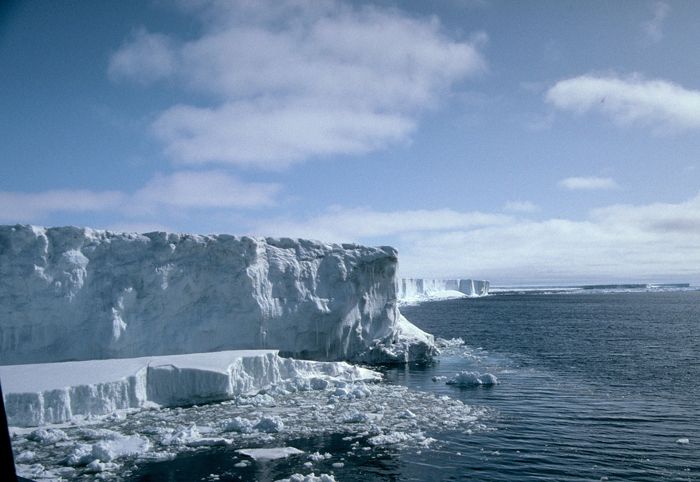Melt from Below Helping Shrink Antarctic Glaciers

The ice that Antarctica is losing as chunks break off the continent's many glaciers may be only the tip of the iceberg. Scientists now find much of the ice Antarctica loses is due to melting from the undersides of ice shelves.
During the last decade, the Antarctic ice sheet has been melting an increasing amount each year, mostly in the western portion of the continent. Most of the ice Antarctica loses is replaced by snowfall, but any ice that is not replaced adds to a rise in global sea level.
For many decades, researchers thought that the main cause of this loss of ice was iceberg calving — the breaking off of chunks of ice at the edge of glaciers. Currently, the birth and melting of icebergs causes 670 cubic miles (2,800 cubic kilometers) of ice to leave the Antarctic ice sheet annually, about equal to 700 times the entire domestic water supply for the United Kingdom. [Photo Album: Antarctica, Iceberg Maker]
"Understanding how the largest ice mass on the planet loses ice to the oceans is one of the most fundamental things we need to know for Antarctica," researcher Jonathan Bamber, of the University of Bristol, said in a statement. "Until recently, we assumed that most of the ice was lost through icebergs."
Now, scientists find that far more ice leaves Antarctica by melting from the underbelly of ice shelves than was thought. Ice shelves are the tongue of glaciers that stick into and float on the ocean, acting as a hurdle between glaciers and the sea. These shelves reduce the speed by which glaciers shed ice into the sea, thereby slowing the speed of ice loss. So if the ice shelves continue to loss mass through melting, the speed of ice loss will increase.
"What happened is that the underside of ice shelves was out of sight and out of mind," researcher Mathieu Depoorter, a glaciologist at the University of Bristol in England, told LiveScience.
'Complete change of view'
Sign up for the Live Science daily newsletter now
Get the world’s most fascinating discoveries delivered straight to your inbox.
The researchers used observations from satellite and airborne missions to accurately measure the speed and volume of ice flowing away from Antarctica. They compared this data with a climate model for snowfall over the ice sheet to estimate how much ice was accumulating on the continent and how much was leaving it.
For some ice shelves, melting on their undersides could account for as much as 90 percent of the mass they lost. For others, it was only 10 percent. This discovery represents a "complete change of view for the fate of ice-shelf ice," Depoorter said.
Indeed, a recent study found warm seawater under the Pine Island Glacier in Antarctic is spurring rapid melting. That glacier is the longest and fastest-changing glacier on the immense West Antarctic Ice Sheet, and its breakup could lead to even more ice flowing into and melting in the ocean. [Images of Melt: Earth’s Vanishing Ice]
The researchers found this subshelf melting has as large an impact as iceberg calving for Antarctica as a whole.
"We come from a longstanding view where ice shelves lose their mass almost entirely through calving at the ice shelf front — 80 percent — to a view where calving and underside melting are similar in magnitude for the loss of ice-shelf ice, a 50/50 ratio," Depoorter said.
"These findings are crucial for understanding how the Antarctic continent is losing its ice to the ocean, and therefore how it behaves now and will react in the future," Depoorter added.
A study appearing in a June issue of the journal Science also found that melt from below was a primary force eating away at Antarctica's ice shelves, and calculated that these ice shelves were thinning by about 1.6 feet (50 centimeters) per year.
Future work on glaciers will include continuous surveys of ice shelves and investigations to understand patterns in the accumulation and melting of ice.
"All this will enable more accurate representations of the physical processes in atmosphere-ice-ocean interaction models and therefore more accurate predictions for the fate of ice shelves in the future," Depoorter said.
The scientists detailed their findings online Sept. 15 in the journal Nature.
Follow us @livescience, Facebook & Google+. Original article on LiveScience.












